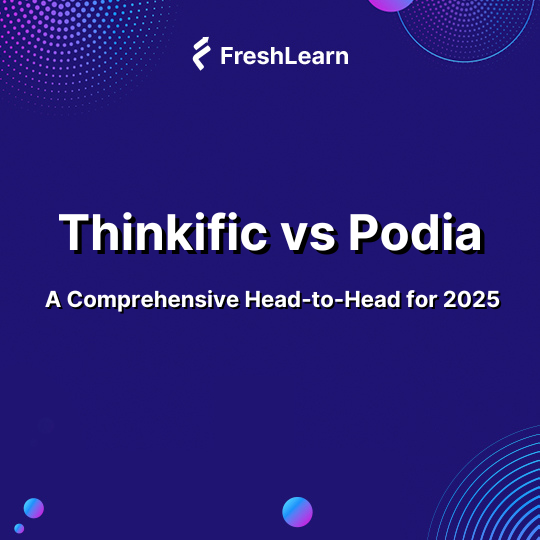
Thinkific vs Podia: A Comprehensive Head-to-Head for 2025
When we asked a handful of creators who’ve used both platforms, the same thing kept popping up: Thinkific feels powerful; Podia feels easy.
That squares with what we saw reading public reviews. On G2, Thinkific gets praised for structure and support; great when you want detailed learning paths and reporting.
Podia, meanwhile, earns love on G2 for being an all-in-one solution that helps solo creators create and deliver fast without extra tools.
Not every review is good, of course. Trustpilot threads for both platforms include frustrated posts about glitches or support, and the occasional “this was harder than I expected.”
So here’s how we’re approaching it: we’ll find out who each platform is best for, show how they differ in course building, engagement, marketing, websites, and pricing, and then offer scenario-based picks so you can match a platform to your next 6 to 12 months of work.
And because many readers ask for a third option, we’ll also introduce an alternative that’s arguably better than both. Read on.
Thinkific vs Podia: Quick Comparison
If you’re in a rush and just want a bird’s eye view of how Thinkific and Podia compare, this section is for you.
Here's what we have to say:
Thinkific is best for educators, training teams, and businesses that want an in-depth, academic-style learning experience.
Podia is best for solo entrepreneurs and small teams who want an incredibly simple all-in-one setup to sell courses, memberships, and digital downloads without stitching together multiple tools.
Before we dive into the full feature breakdown, here’s a quick table that compares the main areas most creators care about:
A Brief Overview of Thinkific
Thinkific is a professional-grade platform for building and delivering structured online education. It’s designed for creators and training teams who want control: detailed course outlines, prerequisites, content dripping, graded quizzes, certificates, and flexible compliance rules.
You can shape a full website with themes and custom pages, connect analytics and email tools, and extend capabilities through an app marketplace and integrations.
If your goal is an academy-like experience with clear learning paths and measurable results, Thinkific gives you the knobs and dials to build it.
A Brief Overview of Podia

Podia is an all-in-one creator platform that makes selling digital products feel simple.
From one dashboard, you can launch courses, memberships, and downloads; build straightforward sales pages; run email newsletters and automations; and host a community that ties directly to your offers.
The interface favors clarity over complexity, which means faster setup and fewer decisions.
Podia is a comfortable fit if you want to publish quickly, keep your stack minimal, and manage your audience and products in one place.
Feature-by-Feature Comparison: Thinkific vs. Podia
Now that we have a high-level understanding of what both Thinkific and Podia offer, let’s go deeper and compare the platforms’ top features.
sounds easy on paper, but it's rarely easy. Between creating the course, editing it, putting it online, and managing the backend, many creators just give up on the process midway.
That’s why we think that it’s critical for a course creation and LMS tool to make the process of creating and managing a course pain-free.
Let’s see how our contenders stack up here:
Thinkific

Thinkific’s course builder tries to balance power and clarity. The drag-and-drop interface lets you slot videos, PDFs, text lessons, live-stream blocks, and even SCORM or HTML5 packages directly onto your outline while previewing the end-user flow in real time.
A dozen native lesson types, including surveys, discussions, and downloadable assignments, are just a click away, so you rarely need external tools.

Thinkific’s best feature is arguably its granular release control.
You can gradually schedule chapter uploads by calendar date or by the number of days after enrolment, enforce passing scores before progression, and chain multiple prerequisites together to customize learning paths.
These rules also let you lock lessons, so bonus modules stay hidden until students finish earlier content or watch an upsell video.
Podia

Podia takes the opposite direction: it prioritizes speed over sophistication.
Its minimalist builder guides you to a clean lesson list. You can drag files in bulk, rearrange them as you wish, and publish.
That’s all it takes to get your lessons live; it's an ideal workflow for a first-time creator who needs momentum rather than playing around with micro-settings.

The interface is intentionally simple and mirrors the platform’s “all-in-one for solopreneurs” philosophy. However, once your curriculum grows past a few modules, the lack of student surveys, memberships, course reviews, etc., can become noticeable.
Winner: Thinkific
If your course is short and self-paced, and you want to get it live fast, Podia’s simplicity is refreshing. But Thinkific’s course builder focuses on the students’ learning experience, and offers a lot of customizability and flexibility, which gives it the win.
2. Quizzes, surveys, and assessments
Thinkific

Assessments on Thinkific are built into the pedagogy.
You can mix multiple-choice, short-answer, and true/false items, import entire question banks from Excel, and let the system randomize questions so each student sees a unique exam.
You can set passing scores, time limits, and retake rules for each quiz. The results are shown in analytics dashboards, making it easy to spot content gaps.

You can also use automated grading handles and optional feedback messages to explain correct answers on the spot. And once your learner reaches a particular stage in the course, Thinkific can trigger automatic certificates (custom-branded or third-party).
For even more assessment options, just add any engagement and assessment app from Thinkific’s App Store, like Beastnotes, Ding, or Adaptive SimpleSim.
Podia

Assessments on Podia are more limited in comparison. Podia’s quiz tool covers the basics; you get single-answer multiple-choice questions with an optional completion certificate.
Setup is quick; just choose “Add Quiz,” type your questions, and you’re done.

However, there’s no:
- Question randomization,
- Short-answer grading,
- and no deep analytics beyond a simple pass or fail indicator.
For simple knowledge checks or audience polls, that may be enough, but serious educators will soon bump into the ceiling.
Winner: Thinkific
Because assessment shapes learner motivation as much as content does, depth matters. Thinkific’s ability to add quizzes into learning paths, provide immediate feedback, and offer certificates places it far ahead of Podia’s simplistic quizzing system.
3. Community and student engagement
For course creators, it’s often essential to have an engaging community where your audience can come together to build meaningful relationships and share interests and common goals.
Apart from increasing engagement, communities also result in higher retention rates because they instill a sense of communal achievement in learners.
Let’s see how Thinkific and Podia compare here.
Thinkific

Thinkific approaches the community as an extension of its learning environment.
At the lesson level, you can switch on “on-Lesson discussions,” which gives each video or PDF its own thread so learners can post questions right as they digest the content.
Admins can moderate, hide posts, and reply directly from the dashboard. Students can add images or files to their posts to make their discussions more engaging.
Beyond individual lessons, Thinkific’s full-blown online learning environment, called Thinkific Communities, lets you:
- Start a branded space with sub-spaces
- Create live-event rooms
- Curate trending posts, and
- Assign granular moderator roles.
You can even sell the community as a standalone product or bundle it with a course to open new revenue streams without relying on third-party forums.
Podia

Podia, by contrast, makes community a pillar of the entire platform rather than an add-on. This community-centredness reminds us of another learning platform: Skool.
The Community tab sits alongside Courses, Email, and Webinars. Moreover, every customer login is also a community login, so discussion feels natural rather than added on.
You can run free or paid tiers of your community, gate topics to specific membership levels, and automatically grant access when someone buys a product or joins a bundle.

Because community, checkout, and email are in the same space, it's easy to pitch a premium “VIP Lounge,” tag members for segmented broadcasts, and track revenue without separate tools.
The emphasis is less “forum attached to a course” and more “membership business with courses attached,” which goes well with creators who see recurring community revenue as their primary offer.
Winner: Podia
For entrepreneurs who want to monetize belonging, whether via tiered access, paid challenges, or ongoing challenges, Podia’s integrated, sellable community wins the round.
4. Sales and marketing
Now, once you've prepared your course, you want to attract learners and expand your business.
This is where the sales and marketing powers of your platform take the lead.
Let’s see how Thinkific and Podia stack up here:
Thinkific
Thinkific offers a whole stack of marketing tools, plus an ecosystem to extend them. Here’s a list of all marketing tools on offer:
- AI landing pages to create conversion-ready sales pages fast
- Site Builder for customizable sales pages (with upsell sections)
- Sales widgets (embeddable buy buttons/cards) for any external site
- Direct-to-checkout links you can drop on outside pages
- Coupons (incl. bulk options and auto-applied coupon links)
- Bundles to package multiple products under one offer
- Order bumps to add one-click offers in checkout
- After Purchase Flow with upsells on the thank-you page
- Subscriptions, payment plans, and free trials for flexible pricing
- Affiliate tracking to attribute sales and manage payouts
- Email Automation (limited to sales sequences and abandoned-cart emails), and more.
With the Site Builder, you can create a sales page, add blocks for testimonials and guarantees and publish without touching code. Themes are also present to keep pages on-brand across your site.

The App Store is a major pro here. If you need deeper CRM, pop-ups, referrals, or advanced email, all you do is install apps from providers like HubSpot, EngageBay, EarlyParrot and more. This keeps Thinkific light while letting you add on specialized tools as you grow.

If you run paid communities or want mobile-first sales, the Branded Mobile App adds another marketing surface.
Your courses and communities live in a white-label app on iOS and Android. You can customize branding and enable in-app purchases, then drive push-notification campaigns that bring learners back.
Podia
Podia takes a more connected approach to marketing. It comes with built-in email, so newsletters and automated campaigns run without the need for investing in extra software.
We love the email builder. It’s visual, has ready-to-send templates, and segmentation is straightforward.

Campaigns use entrance and exit conditions, so you can send the right message based on what someone bought or viewed. This keeps operations simple for solo creators and small teams.

Moreover, Podia’s website and landing pages connect directly to products, email, and checkout.
You can launch unlimited sales pages and capture leads without extra plugins.
Checkout is fast too. Podia also includes affiliates, coupons, upsells, and multi-currency support so that you can run the core funnel end-to-end inside one platform. It’s an easy setup when you want to sell quickly.
Other marketing tools that come with Podia include:
- A blog integrated with your products and email
- Product waitlists & pre-launch capture, plus automatic confirmation emails
- Direct checkout links you can share anywhere
- Upsells at checkout to lift average order value
- Coupons and discount codes
- Product bundles to package multiple offers under one price
- Affiliate program (available on the Shaker plan)
- Webinars (Zoom or YouTube Live) with paid access and replay sales
Winner: Tie
Thinkific wins on extensibility, branded mobile presence, and a growing native email feature. Thinkific will appeal more to creators who value flexibility and integrations.
Podia wins on simplicity by bundling email, pages, checkout, affiliates, and automations in one place.
5. Ease of Use and User Experience
Everyone expects onboarding to be smooth, be it for an app, a service, or something else.
And we had similar expectations while testing these as well.
Thankfully, we didn’t run into any hiccups with either Thinkific or Podia.
Both platforms get you up and running quickly: create an account, name your first product, and you’re dropped into a guided setup. You’ll see prompts to add a lesson, price the offer, and publish a basic page.
Now, let’s talk about how these platforms are to use.
Thinkific

Thinkific’s interface is clean, but there’s a lot of power tucked into menus: course settings, communities, bundles, coupons, apps, and analytics.
That depth is the draw, and also why the first hour can feel busy.
- Expect a short learning curve while you see and learn where everything is
- The course builder is visual and orderly; the advanced bits (prerequisites, dripping, completion rules) sit one level deeper
- There is a setup checklist, starter templates, and inline tips that explain why a setting matters
If you like having knobs and dials, Thinkific is satisfying. If you don’t, it may feel like too many choices at first.
Podia

Podia’s UI is intentionally minimalist. When you click into a section or menu, there’s usually a single main screen with obvious next steps.
Podia’s settings are described in plain English and rarely require cross-checking another screen.
For non-technical users, Podia is friendly and predictable. You lose some advanced options for speed and focus, which is often the right call when momentum is the priority.
Verdict: Thinkific is powerful but asks for a bit more familiarization. Podia is highly approachable and also simpler.
6. Third-Party Integrations
This is again an area where you’ll notice the differing philosophies of Thinkific and Podia. Thinkific is built to work with the best tools out there.
You can keep your favorite email service, analytics suite, and CRM, then connect them through native integrations or apps.
Podia, on the other hand, is built to replace most of that stack. Email, pages, checkout, coupons, and affiliates are already inside, so the number of external tools you need goes way down.
Some Thinkific integrations of note include the following.
- Zapier and webhooks: Let you send data to thousands of apps (for instance, you can add buyers to your CRM, tag subscribers, trigger tasks).
- Email and CRM (direct): You can connect major providers for lists, tags, and automations without extra glue.
- Analytics: Drop in tracking (like Google Analytics, Meta pixel) and map events like views, signups, and purchases.
- Payments and commerce: You get Stripe and PayPal plus an app marketplace for referrals, pop-ups, reviews, and more.
- Live, video, and extras: Common tools like Zoom are available as native apps or in the marketplace.
If we had to point out some critical Podia integrations, we’d pick the following.
- Zapier: Again, very useful when you do want handshakes with outside tools
- Analytics and pixels: Simple fields for Google Analytics and ad pixels so you can measure and retarget
- Payments: Stripe and PayPal built in; taxes, coupons, and upsells are handled natively
- Email and landing pages: Since these are built in, many creators won’t integrate a separate sender or page builder at all
Winner: Thinkific
The bottom line is that Thinkific embraces integrations and an app ecosystem so you can assemble your ideal setup. Podia reduces integration needs by bundling the essentials, then gives you Zapier and basic tracking for the rest.
So far, the trend has been that Thinkific is better in some areas, and Podia wins in others. But what if we told you, there’s a Thinkific alternative (so naturally, also a Podia alternative) that offers the best of both tools, without the compromises?
Yes, that’s Freshlearn.
A credible alternative: FreshLearn
If you like Thinkific’s depth and Podia’s simplicity but want one place to run the whole business, FreshLearn is worth a serious look.
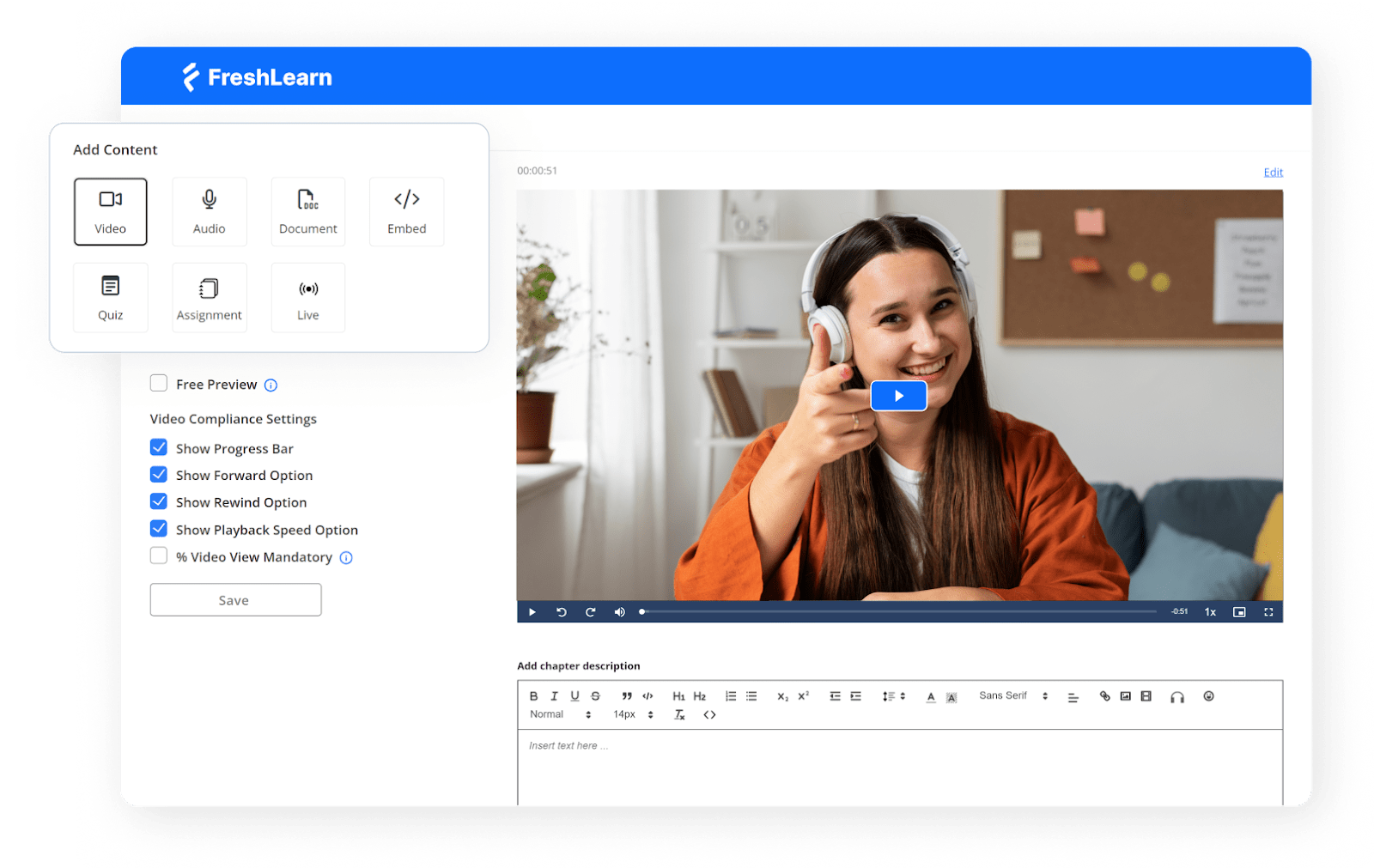
It brings course creation, cohorts, community, email, websites, assessments, and a mobile app in one place, with add-ons like AI agents and white-label apps when you’re ready to take it up a notch.
What stands out
- Create once, ship in many formats: FreshLearn lets you build on-demand courses, live cohorts, workshops, and even Netflix-style playlists from the same dashboard. So you can teach asynchronously, run live sprints, or package video libraries without switching tools.
- A builder that also markets for you: You can create a sales page with templates or lean on AI to generate sections, copy, and layouts, then publish instantly. It’s fast when you need it and flexible when you want to refine the brand.
- Native email that just works: FreshLearn includes list building, broadcasts, and automated campaigns with tracking. You can welcome new students, nudge prospects, and measure results without wiring up a separate sender.
- Assessments and proof of completion: Quizzes support multiple choice, multi-select, and short answer, with pass marks and even negative scoring if you want a stricter evaluation. Pair that with auto-issued completion certificates, and you have an assessment system built in.
- A vibrant community: If you’re leaning into membership revenue, FreshLearn’s community adds support topics, moderation, memberships, and gamification. You can bundle the community with courses or sell it on its own.
- Mobile, branded your way: When you’re ready, launch white-label iOS and Android apps that help learners get an actual on-the-go experience, with your name and icon, not someone else’s. It’s a strong lever for engagement (and push notifications).
- Pacing and structure built in: Drip scheduling lets you release content over time and send notifications as new modules unlock. Great for cohorts, challenges, or longer programs.
- Easy live teaching: Run masterclasses and live sessions, and, if you connect Zoom, schedule and host directly from FreshLearn. It’s handy for bonus Q&As, office hours, or cohort kickoffs.
- Room to integrate when you want: With Freshlearn, you’re not locked in. There’s an API for custom connections, a HubSpot integration for customer data workflows, and Zapier or Pabbly-style options when you want to automate around the edges.
FreshLearn covers the course lifecycle end-to-end. It makes it easy for you to plan and build, sell with solid pages and email, deliver with quizzes and certificates, engage with the community, and extend with mobile and integrations.
If you’re comparing platforms, this is the option that lets you launch quickly and still mature into a richer learning business, without having to rebuild your stack every few months.
Detailed pricing analysis: Thinkific vs Podia (with ROI)
Finally, we believe that pricing is the biggest deciding factor when you choose a tool you’ll use every day to run your business.
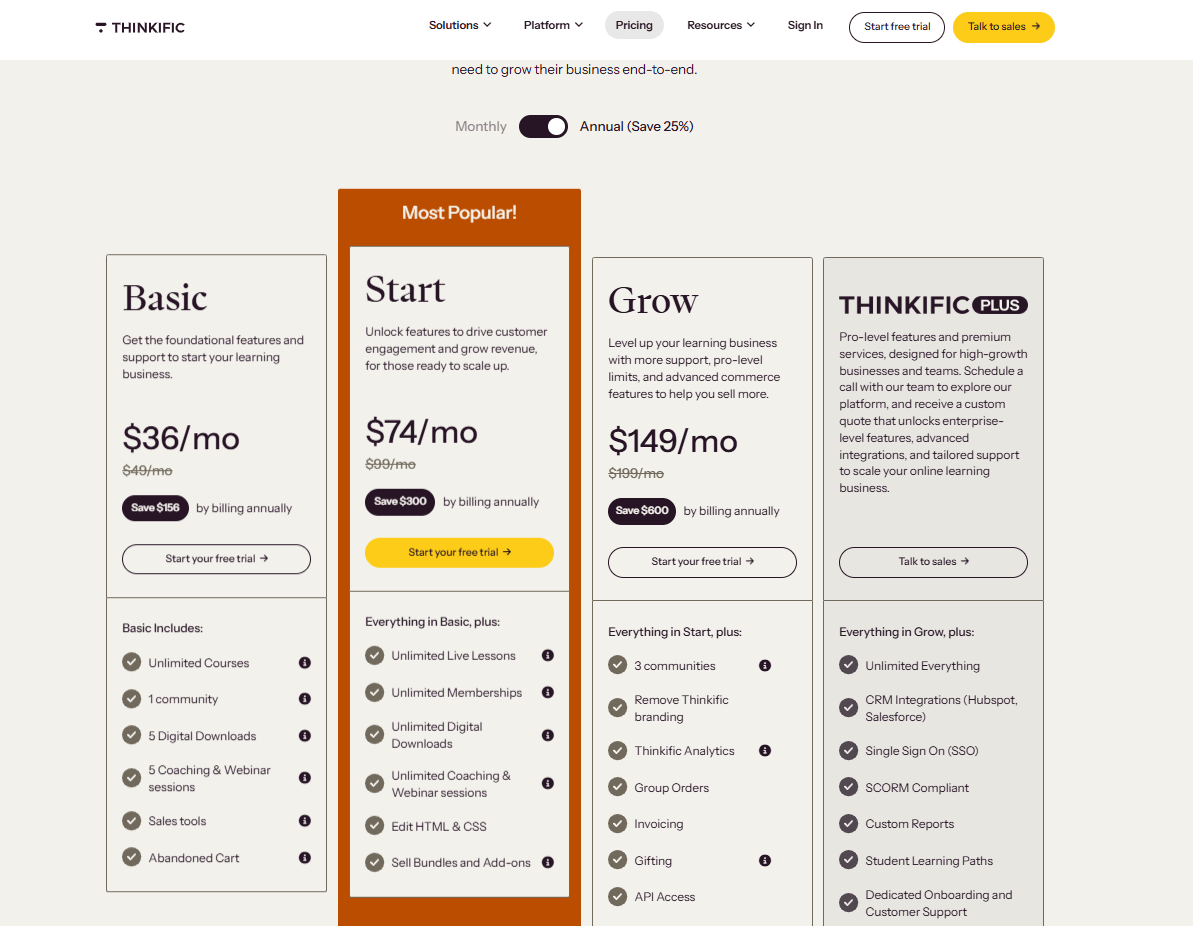
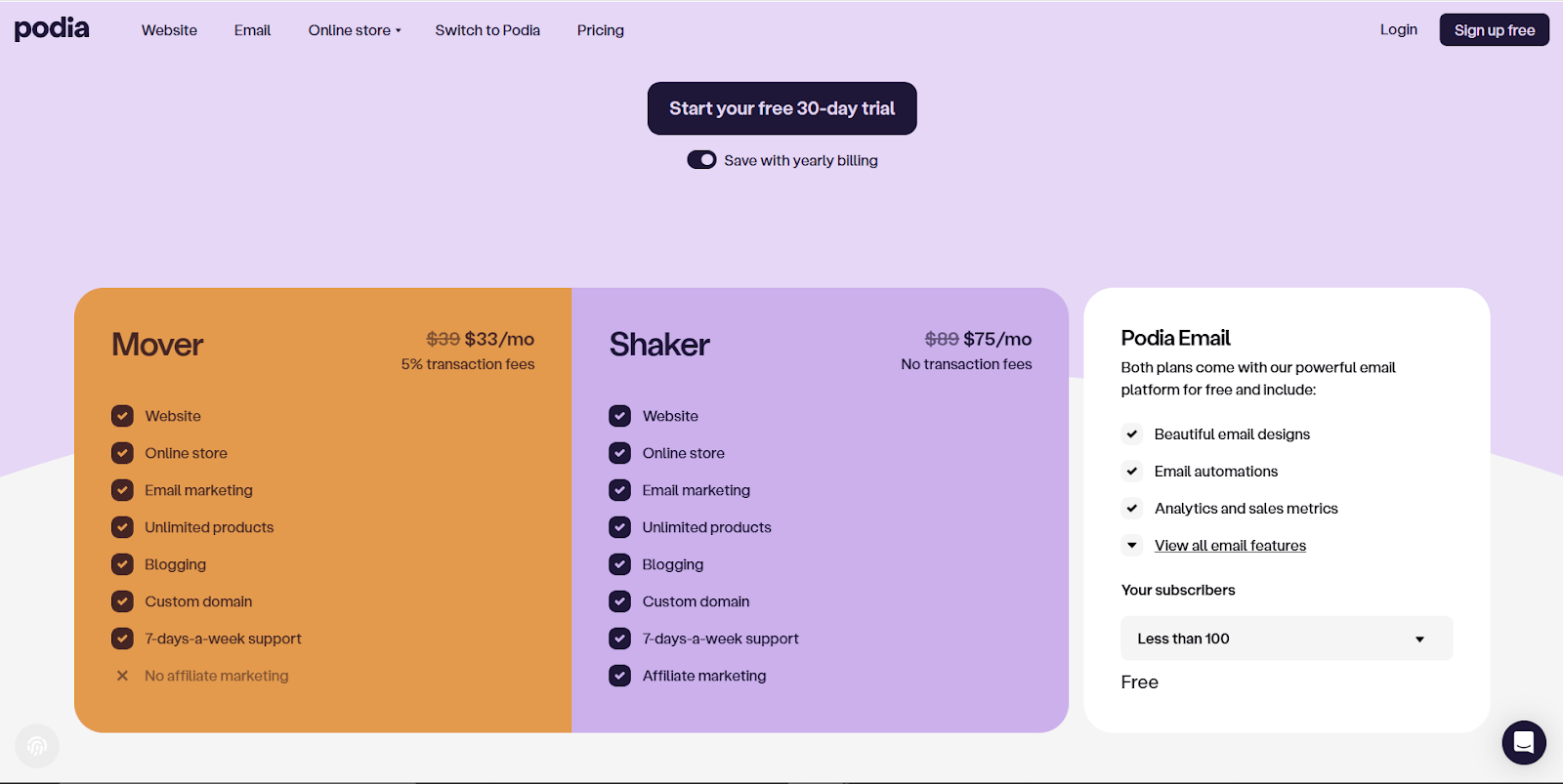
Ideally, what you pay for the tool should be much less than the revenue the tool brings you.
With that in mind, let’s see how Thinkific and Podia’s pricing compares.
These are the base prices for both the software. Thinkific currently offers a 25% annual discount; unfortunately, there’s no free plan. With Podia, you do get a 30-day trial.
Payment processing and other fees you should expect
Regardless of platform, you’ll pay card processing (typically 2.9% + $0.30 per transaction) to Stripe/PayPal.
Note that if you don’t use Thinkific Payments, an additional third-party gateway fee may apply depending on the plan. Using Thinkific Payments avoids that extra gateway fee.
External tools to consider
Podia includes native email; you only pay more as your list size grows beyond the included thresholds. Thinkific now includes Email Automation, but many teams still connect a dedicated sender for advanced campaigns, hence the external line item below.
- Email marketing (if you outgrow built-in tools or prefer a specialist): Mailchimp Essentials from $13/mo for 500 contacts; Standard from $20/mo for 500 contacts; Kit $29/mo for up to 1,000 subscribers on Creator
- Automation and Integrations: You’ll pay for optional Zapier tiers if you automate heavily (cost varies by usage)
- Domain: Registering your custom domain is separate (yearly registrar cost)
ROI Scenario Examples
To make this pricing comparison concrete, assume a $100 average order value (AOV). Card processing is calculated at 2.9% + $0.30 per order for both platforms. We’ll compare Podia’s two plans against Thinkific’s Start (the mid-tier used by many growing creators).
Scenario A: $1,000 in monthly sales
That’s 10 sales at $100 each; processing per order around $3.20 (2.9% of $100 + $0.30), which means $32 total processing.
At roughly $1,000/mo in revenue, Podia Mover and Shaker cost the same overall, because 5% of $1,000 equals the $50 plan-price gap.
That’s also your break-even point for choosing Shaker over Mover. Above $1,000/mo, Shaker is cheaper than Mover; below $1,000/mo, Mover is cheaper.
Scenario B: $10,000 in monthly sales
Again, that’s 100 sales, and processing will come to $320.
At higher volumes, Podia Shaker and Thinkific Start are close on pure cost. But Podia Mover’s 5% fee becomes expensive as revenue grows.
After putting all of this together, ultimately, we realized that the cheapest setup depends on your revenue band and billing cadence. Podia Mover is attractive for new creators; Shaker and Thinkific Start become better long-term as sales grow.
- If you’re on low, variable revenue (less than $1,000/month), Podia Mover is cost-efficient, and so is Thinkific Basic if you’re okay with fewer features. Processing fees apply either way.
- When you hit steady revenue (over $1,000/month), move to Move to Podia Shaker or Thinkific Start. With annual billing, their effective monthly prices are $75 (Shaker) vs $74 (Start) — nearly identical, so the decision depends on features and workflow rather than raw price.
If these costs are still too high for you, you can consider Freshlearn. Freshlearn gives you more for the same amount of money.
Why FreshLearn is arguably the better value
FreshLearn’s pricing is straightforward. There are 0% platform transaction fees, unlimited enrollments, and included email credits on each paid tier.
You can pay monthly, annually, or even on a two-year cycle to save as much as 40%.
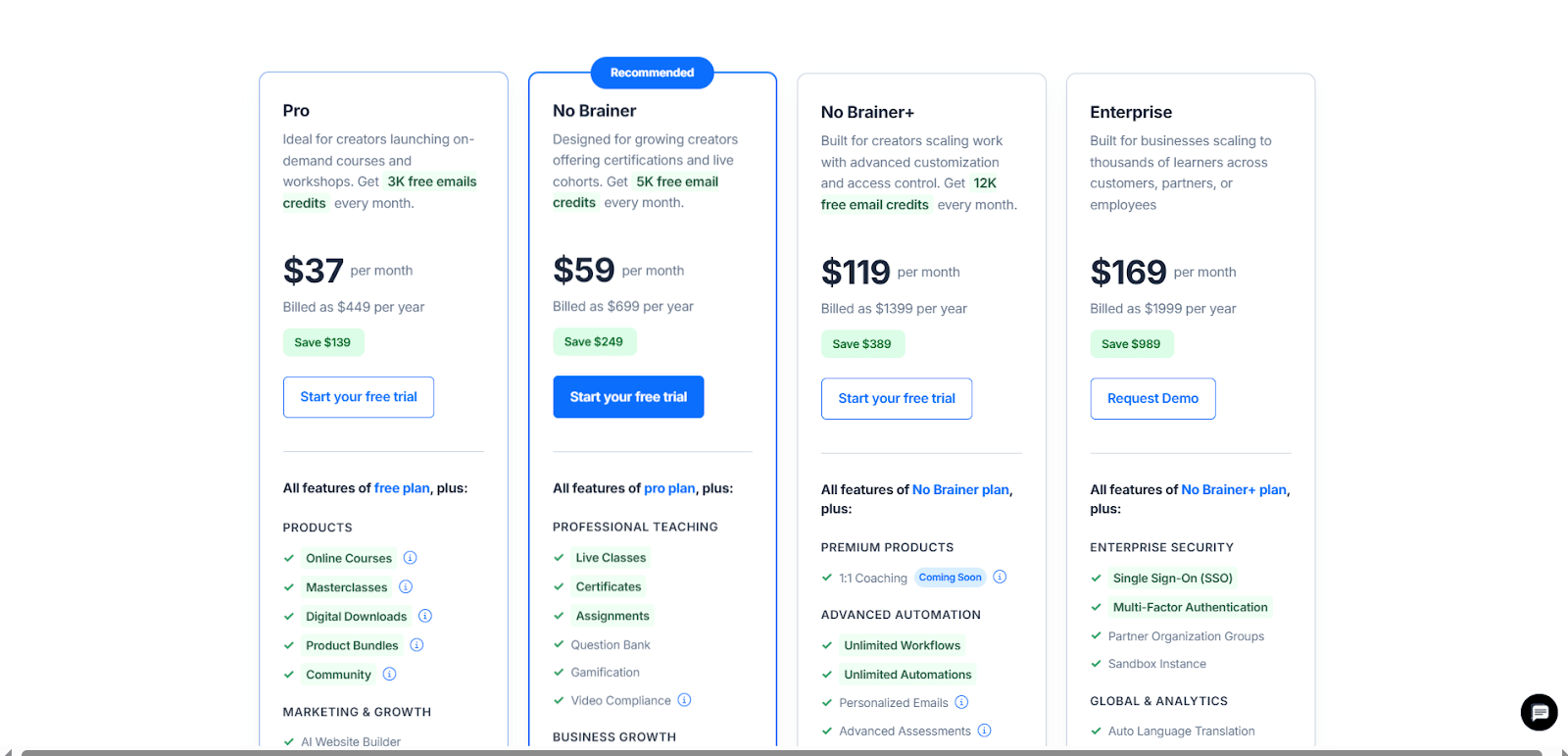
These are the pricing plans at a glance:
FreshLearn bundles email marketing and automations with monthly credits.
If you outgrow those credits, overages are predictable at $0.004 per send.
For context, 5,000 sends of a launch sequence would cost $20, which means it's less than a separate email service for small lists.
Podia includes email, but pricing scales with subscriber count after the first 100; the exact add-on depends on your list size.
Thinkific includes Email Automation features, but many teams still pair it with a dedicated sender for full newsletter + list growth workflows; if you do that, add the cost of a separate email tool.
These are other reasons why Freshlearn can be a better deal:
- Lowest friction at common revenue bands: In the $1,000 to $10,000/mo range, FreshLearn’s subscription and 0% fee usually saves you $10 to $50 more per month.
- Email credits reduce add-ons: The bundled monthly email credits have a tangible dollar value. If you run regular broadcasts and launch sequences, that’s money you don’t have to spend elsewhere.
- Long-term discounts: The two-year option is rare in this category and pushes effective monthly rates down to $29, $46, and $89 on the main tiers. That’s hard to beat if you’re committed to the long haul.
The Final Verdict: Which Platform Is Right for You?
Here’s the quick, no-drama wrap-up so you can choose with confidence.
Core strengths at a glance
- Thinkific: Power, control, and academic rigor. You get granular course structure, robust assessments, and the flexibility to build a fuller website around your programs.
- Podia: Simplicity, all-in-one functionality, and community focus. It’s fast to launch, easy to run from one dashboard, and great for creators who want minimal setup.
- FreshLearn: A powerful hybrid. Advanced engagement (assignments, certificates, gamification), 0% transaction fees, built-in email, websites, communities, and even white-label mobile, without a big tool stack.
Choose Thinkific if…
- You’re building a formal online school, academy, or certification program
- You want question banks, randomized quizzes, passing thresholds, prerequisites, and completion rules that shape the learning path
- You care about site depth and branding control. You plan to create multiple custom pages, personalize themes (even at the code level if you want), and position your school as a standalone site
- You don’t mind a short learning curve in exchange for sophisticated controls and an integration-friendly ecosystem
- You prefer “best-in-class” tools stitched together; Thinkific in the center, specialist apps around it
Choose Podia if…
- Speed and ease are the top priorities. You want to upload content, write a clean sales page, and start selling today.
- You like everything in one place: email, pages, checkout, coupons, affiliates, and a community you can sell as a product.
- You also offer digital downloads, webinars, product bundles, and you want to manage them from a single sidebar.
- You value a friendly, uncluttered UI and straightforward settings that don’t require cross-checking other screens.
- Your business model leans on memberships or a community-first experience, and you want that front and center.
Choose FreshLearn if…
- You want the best of both worlds: serious learning features and a cohesive, all-in-one workflow.
- Engagement is central to your teaching: assignments, certificates, drip, and gamification help you pace learning and reward progress.
- You want to maximize profit by avoiding platform transaction fees. (Processor fees still apply, as with any platform.)
- You plan to run marketing in-house, like email broadcasts and automations, landing pages, blogs, without adding on extra tools.
- Mobile matters for your audience, and you’d like a white-label app when you’re ready.
- You want a generous way to start: FreshLearn’s free tier lets you set up, test your offer, and get your first learners in the door before upgrading, which makes early experimentation less risky.
How to make the call in 60 seconds
- List your top three non-negotiables. Is it assessments, community, or a quick launch?
- Decide your stack philosophy. Prefer a platform that integrates with best-in-class tools (Thinkific), or a platform that replaces most of them (Podia), or a hybrid with advanced features built in (FreshLearn)?
- Project your next 6 to 12 months. If you’ll add cohorts, deeper assessments, or a branded mobile app, pick a platform that already supports that step, not one you’ll outgrow.
- Run the total-cost check. Subscription + processor fees + any extra tools (email, landing pages, analytics). If avoiding add-ons matters, FreshLearn often lands as the tidiest invoice.
- Ship a small pilot. Publish one product, a simple landing page, and a short email sequence. The platform that helps you do this fastest, without compromises you’ll regret, is the right one.
The Final Verdict: The Best Tool is the One that Makes You Think About It Less
We’ve spent time in both camps: building structured curricula the “Thinkific way” and shipping fast with Podia’s all-in-one flow.
The pattern is this: Thinkific shines when you want control over learning paths and assessments. Podia keeps momentum high with an uncluttered dashboard and built-in email and community.
What many teams really want, though, is the control to design meaningful learning, plus the speed to market without using five tools together. And that is only satisfied by Freshlearn.
If you want both ease and depth, with room to scale into cohorts, community, mobile, and automations, FreshLearn is the balanced choice.
You don’t have to take our word for it. See it in action with your content and workflows.
Book a FreshLearn demo and decide if it’s the right fit for your next launch.
FAQs
1. Which platform is best for beginners?
If you want the smoothest start, pick Podia, as the UI is very straightforward. Thinkific has more power and a mild learning curve. FreshLearn sits in the middle: simple to launch, with advanced options when you need them.
2. Do these platforms charge transaction fees?
- Thinkific: 0% platform fee when you use Thinkific Payments (processor fees still apply).
- Podia: Mover has a 5% fee; Shaker has 0% (processor fees still apply).
- FreshLearn: 0% platform fees on all paid plans (you’ll only pay Stripe/PayPal fees).
3. Can I sell memberships and build a community?
Yes. Podia treats the community as a core, sellable product tied to memberships. Thinkific offers lesson-level discussions and full Communities.
FreshLearn includes communities with gamification and lets you bundle them with courses or run them standalone.
4. Who has the strongest assessments and certifications?
Thinkific leads for advanced assessment, with question banks, prerequisites, completion rules, and certificates. Podia is fine for simple knowledge checks. FreshLearn covers quizzes, assignments, drip pacing, and auto-issued certificates.
5. Can I bring my own email, or do I have to use the built-in tool?
All three let you connect to external email providers if you prefer. Podia and FreshLearn include built-in email for broadcasts and automations; Thinkific now has native Email Automation, but many teams still connect a dedicated sender for advanced campaigns.



